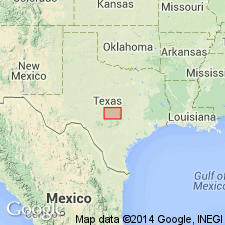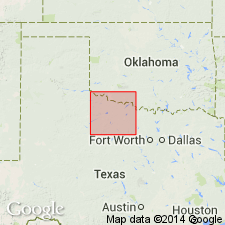
- Usage in publication:
-
- Jacksboro limestone member
- Modifications:
-
- Original reference
- Dominant lithology:
-
- Limestone
- AAPG geologic province:
-
- Bend arch
- Fort Worth syncline
Summary:
Pg. 133-145. Jacksboro limestone member of Jacksboro formation. Top member of Jacksboro formation. Plays out in the sandstone hills southwest of Jacksboro, [Jack County], and appears again in section north of Finis [now a ghost town, http://www.texasescapes.com/], on Mineral Wells-Graham road, easternmost Young County. [Age is Pennsylvanian.]
[Named from exposures in vicinity of Jacksboro, Jack Co., Brazos River region, central northern TX.]
[GNC remark (ca. 1936, US geologic names lexicon, USGS Bull. 896, †Jacksboro formation entry p. 1034): According to F.B. Plummer and R.C. Moore, 1922 (Univ. Texas Bull., no. 2132, p. 138 and table 2), Jacksboro limestone member of Graham formation is characterized by CAMPOPHYLLUM TORQUIUM, but CAMPOPHYLLUM bed of Drake is the much younger Gunsight limestone member of Graham formation.]
Source: US geologic names lexicon (USGS Bull. 896, p. 1034-1035).

- Usage in publication:
-
- Jacksboro limestone member*
- Jacksboro limestone lentil
- Modifications:
-
- Principal reference
- Dominant lithology:
-
- Limestone
- Sandstone
- Shale
- AAPG geologic province:
-
- Bend arch
- Fort Worth syncline
Summary:
Pg. 127-143. Jacksboro limestone member (also called Jacksboro limestone lentil). A limestone near base of Graham formation (of Cisco group) in Brazos River Valley. In vicinity of Jacksboro it consists of 2 limestone beds separated by 12 feet of sandy shale and sandstone. Total thickness of member 25+/- feet. Overlies Finis shale and underlies Gonzales Creek shale and sandstone, all members of Graham formation. The lower limestone bed is dark gray (weathering rusty yellow), hard, crystalline, 1 to 4 feet thick, and filled with CAMPOPHYLLUM TORQUIUM. The upper limestone is poorly bedded, massive, shaly, 6 to 18 feet thick, in places very fossiliferous, and 5 or 6 miles to southwest changes to calcareous sandstone, and to northeast, of Jacksboro grades into shales. [Age is Pennsylvanian.]
Source: Publication; US geologic names lexicon (USGS Bull. 896, p. 1034-1035).

- Usage in publication:
-
- Jacksboro limestone member
- Modifications:
-
- Revised
- AAPG geologic province:
-
- Bend arch
- Fort Worth syncline
Summary:
Pg. 104. Transferred Jacksboro limestone and Finis shale to Caddo Creek formation, and stated (p. 112) that Home Creek limestone member includes Jacksboro limestone. [Age is Pennsylvanian.]
Source: US geologic names lexicon (USGS Bull. 896, p. 1034-1035).

- Usage in publication:
-
- Jacksboro limestone member
- Modifications:
-
- Revised
- AAPG geologic province:
-
- Bend arch
Summary:
Pg. 62+. Included Finis shale and Gonzales Creek shale in Graham formation. The USGS draws base of Graham formation at top of Home Creek limestone. This is where base was put by F.M. Bullard and R.H. Cuyler, 1935 (Univ. Texas Bull., no. 3501). [Age is Pennsylvanian.]
Source: US geologic names lexicon (USGS Bull. 896, p. 1034-1035).

- Usage in publication:
-
- Jacksboro Limestone
- Modifications:
-
- Mapped
- AAPG geologic province:
-
- Bend arch
- Fort Worth syncline
Summary:
Jacksboro Limestone [unranked] in Cisco Group. Gray and yellow, thin- to medium- and wavy bedded limestone. Thickness up to 28 feet. Lies below Gonzales Limestone [unranked] in Cisco Group and above Home Creek Limestone of Canyon Group. Rocks included in Graham Formation by earlier workers. Fossils (CANINIA coral). Age is Late Pennsylvanian (Virgil).
Northernmost exposure is West Fork of Trinity River, Jack Co., central northern TX.
Source: Publication.
For more information, please contact Nancy Stamm, Geologic Names Committee Secretary.
Asterisk (*) indicates published by U.S. Geological Survey authors.
"No current usage" (†) implies that a name has been abandoned or has fallen into disuse. Former usage and, if known, replacement name given in parentheses ( ).
Slash (/) indicates name conflicts with nomenclatural guidelines (CSN, 1933; ACSN, 1961, 1970; NACSN, 1983, 2005, 2021). May be explained within brackets ([ ]).

